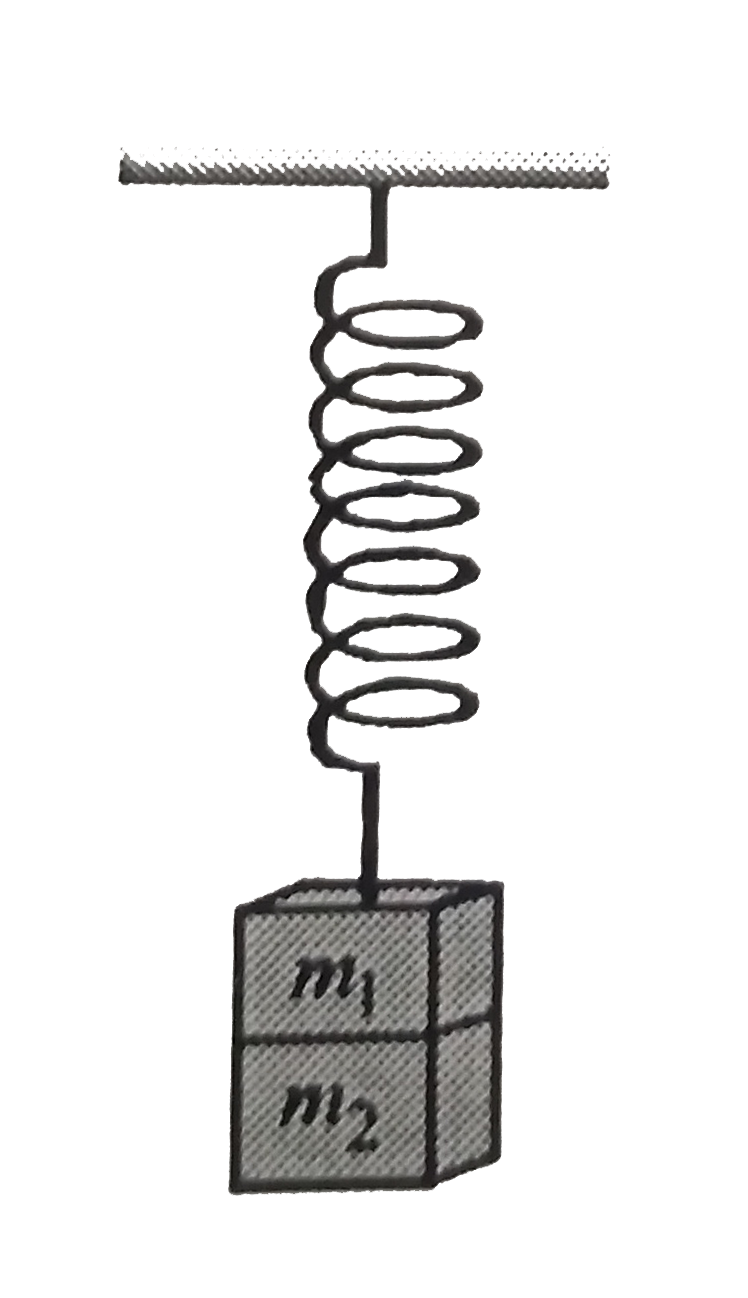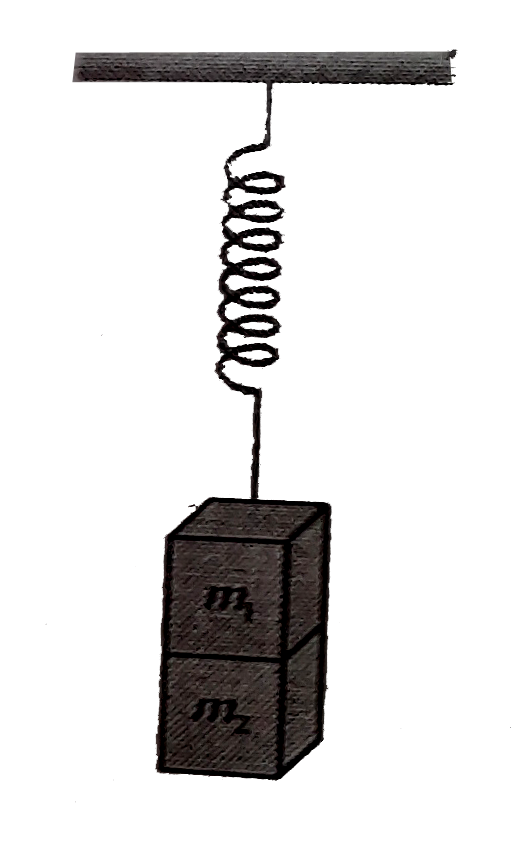Two masses M and m are suspended together by massless spring of force constant -k. When the masses are in equilibrium, M is removed without disturbing the system. The amplitude of oscillations.
Mgk
mgk
(M+m)gk
(M−m)gk
The correct Answer is:A
To solve the problem step by step, we will analyze the situation involving the two masses and the spring, and then derive the amplitude of oscillation after one mass is removed.
Step 1: Understand the Initial Equilibrium Condition
When both masses M and m are suspended together by the spring, the spring is stretched to a new equilibrium position due to the combined weight of the two masses. The force balance at equilibrium can be expressed as:
kx0=(M+m)g
Where:
- k is the spring constant,
- x0 is the initial extension of the spring,
- g is the acceleration due to gravity.
Step 2: Remove Mass M
When mass M is removed, the system will adjust to a new equilibrium position. The only mass remaining is m. The new equilibrium condition can be expressed as:
kx′0=mg
Where x′0 is the new extension of the spring after mass M is removed.
Step 3: Solve for the New Extension x′0
From the equation for the new equilibrium, we can solve for x′0:
x′0=mgk
Step 4: Find the Original Extension x0
From the initial equilibrium condition, we can express x0 as:
x0=(M+m)gk
Step 5: Calculate the Change in Extension
The change in extension of the spring when mass M is removed is given by:
Δx=x0−x′0=(M+m)gk−mgk
Step 6: Simplify the Expression for Change in Extension
Now, simplifying the expression for Δx:
Δx=(M+m)g−mgk=Mgk
Step 7: Determine the Amplitude of Oscillation
The amplitude of oscillation after mass M is removed is equal to the change in extension Δx:
A=Δx=Mgk
Thus, the amplitude of oscillation after removing mass M is:
Mgk
When both masses M and m are suspended together by the spring, the spring is stretched to a new equilibrium position due to the combined weight of the two masses. The force balance at equilibrium can be expressed as:
- k is the spring constant,
- x0 is the initial extension of the spring,
- g is the acceleration due to gravity.
When mass M is removed, the system will adjust to a new equilibrium position. The only mass remaining is m. The new equilibrium condition can be expressed as:
From the equation for the new equilibrium, we can solve for x′0:
From the initial equilibrium condition, we can express x0 as:
The change in extension of the spring when mass M is removed is given by:
Now, simplifying the expression for Δx:
The amplitude of oscillation after mass M is removed is equal to the change in extension Δx:
Topper's Solved these Questions
- SIMPLE HARMONIC MOTIONBook:DC PANDEYChapter:SIMPLE HARMONIC MOTIONExercise:JEE Advanced
Explore 34 Videos
- SIMPLE HARMONIC MOTIONBook:DC PANDEYChapter:SIMPLE HARMONIC MOTIONExercise:More than one option is correct
Explore 50 Videos
- SIMPLE HARMONIC MOTIONBook:DC PANDEYChapter:SIMPLE HARMONIC MOTIONExercise:Exercise 14.4
Explore 4 Videos
- SEMICONDUCTORS AND ELECTRONIC DEVICESBook:DC PANDEYChapter:SEMICONDUCTORS AND ELECTRONIC DEVICESExercise:More than One Option is Correct
Explore 3 Videos
- SOLVD PAPERS 2017 NEET, AIIMS & JIPMERBook:DC PANDEYChapter:SOLVD PAPERS 2017 NEET, AIIMS & JIPMERExercise:Solved paper 2018(JIPMER)
Explore 38 Videos
Similar Questions
Two masses m1 and m2 are suspended together by a massless spring of constant k. When the masses are in equilibrium, m1 is removed without disturbing the system. The amplitude of oscillations is

View SolutionTwo masses m1 and m2 are suspended together by a massless spring of constant K. When the masses are in equilibrium, m1 is removed without disturbing the system. Then the angular frequency of oscillation of m2 is -

View Solution
Knowledge Check
Two masses m 1 and m 2 are suspended together by a massless spring of constant K . When the masses are in equilibrium, m 1 is removed without disturbing the system. The amplitude of oscillations is
 Am1gKBm2gKC(m1+m2)gKD(m1−m2)gK
Am1gKBm2gKC(m1+m2)gKD(m1−m2)gKTwo masses 8 kg 4 kg are suspended together by a massless spring of spring constant 1000Nm−1 . When the masses are in equilibrium 8 kg is removed without disturbing the system. The amplitude of oscillation is
A0.5 mB0.08 mC0.4 mD0.04 mTwo masses m1=1kgandm2=0.5kg are suspended together by a massless spring of spring constant 12.5Nm−1. When masses are in equilibrium m1 is removed without disturbing the system. New amplitude of oscillation will be
A30cmB50cmC80cmD60cm
Two mass m1 and m2 are suspended from a massless spring of force constant k. When the masses are in equilibrium, m1 is removed without disturbing the system. Find the angular frequency and amplitude of oscillations.
View SolutionTwo masses m1=1.0kgandm2=0.5kg are suspended together by a massless spring of force constant, k=12.5Nm−1. When they are in equillibrium position, m1 is gently removed. Calculate the angular frequency and the amplitude of oscillation of m2. Given g=10ms−2.
View SolutionTwo masses m1 and m2 are suspeded togther by a massless spring of spring constnat k (Fig). When the masses are in equilibrium, m1 is removed. Frequency and amplitude of oscillation of m2 are

View SolutionTwo masses m1and m2 are suspended from a spring of spring constant 'k'. When the masses are in equilibrium, m1 is gently removed. The angular frequency and amplitude of oscillation of m2 will be respectively
View SolutionTwo masses m1 and m2 are suspended w together by a light spring of spring constant k as shown in figure. When the system is in equilibrium, the mass m1 is removed without disturbing the system. As a result of this removal, mass m2 performs simple harmonic motion. For this situation mark the correct statement(s).

View Solution

